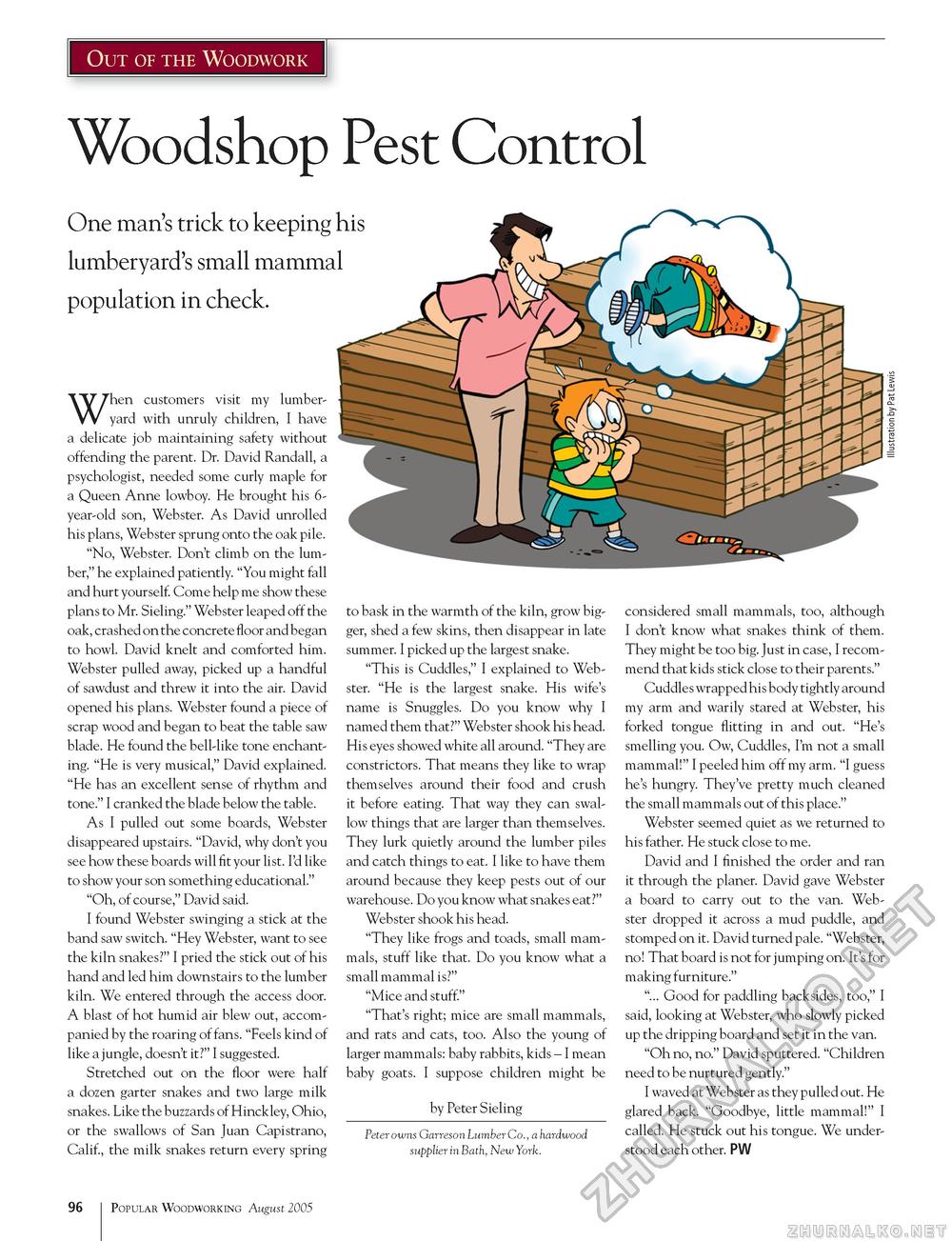Popular Woodworking 2005-08 № 149, страница 98
Out of the Woodwork Woodshop Pest ControlOne man's trick to keeping his lumberyard's small mammal population in check. When customers visit my lumberyard with unruly children, I have a delicate job maintaining safety without offending the parent. Dr. David Randall, a psychologist, needed some curly maple for a Queen Anne lowboy. He brought his 6-year-old son, Webster. As David unrolled his plans, Webster sprung onto the oak pile. "No, Webster. Don't climb on the lumber," he explained patiently. "You might fall and hurt yourself. Come help me show these plans to Mr. Sieling." Webster leaped off the oak, crashed on the concrete floor and began to howl. David knelt and comforted him. Webster pulled away, picked up a handful of sawdust and threw it into the air. David opened his plans. Webster found a piece of scrap wood and began to beat the table saw blade. He found the bell-like tone enchanting. "He is very musical," David explained. "He has an excellent sense of rhythm and tone." I cranked the blade below the table. As I pulled out some boards, Webster disappeared upstairs. "David, why don't you see how these boards will fit your list. I'd like to show your son something educational." "Oh, of course," David said. I found Webster swinging a stick at the band saw switch. "Hey Webster, want to see the kiln snakes?" I pried the stick out of his hand and led him downstairs to the lumber kiln. We entered through the access door. A blast of hot humid air blew out, accompanied by the roaring of fans. "Feels kind of like a jungle, doesn't it?" I suggested. Stretched out on the floor were half a dozen garter snakes and two large milk snakes. Like the buzzards of Hinckley, Ohio, or the swallows of San Juan Capistrano, Calif., the milk snakes return every spring to bask in the warmth of the kiln, grow bigger, shed a few skins, then disappear in late summer. I picked up the largest snake. "This is Cuddles," I explained to Webster. "He is the largest snake. His wife's name is Snuggles. Do you know why I named them that?" Webster shook his head. His eyes showed white all around. "They are constrictors. That means they like to wrap themselves around their food and crush it before eating. That way they can swallow things that are larger than themselves. They lurk quietly around the lumber piles and catch things to eat. I like to have them around because they keep pests out of our warehouse. Do you know what snakes eat?" Webster shook his head. "They like frogs and toads, small mammals, stuff like that. Do you know what a small mammal is?" "Mice and stuff." "That's right; mice are small mammals, and rats and cats, too. Also the young of larger mammals: baby rabbits, kids - I mean baby goats. I suppose children might be by Peter Sieling Peter owns Garreson Lumber Co., a hardwood supplier in Bath, New York. considered small mammals, too, although I don't know what snakes think of them. They might be too big. Just in case, I recommend that kids stick close to their parents." Cuddles wrapped his body tightly around my arm and warily stared at Webster, his forked tongue flitting in and out. "He's smelling you. Ow, Cuddles, I'm not a small mammal!" I peeled him off my arm. "I guess he's hungry. They've pretty much cleaned the small mammals out of this place." Webster seemed quiet as we returned to his father. He stuck close to me. David and I finished the order and ran it through the planer. David gave Webster a board to carry out to the van. Webster dropped it across a mud puddle, and stomped on it. David turned pale. "Webster, no! That board is not for jumping on. It's for making furniture." "... Good for paddling backsides, too," I said, looking at Webster, who slowly picked up the dripping board and set it in the van. "Oh no, no." David sputtered. "Children need to be nurtured gently." I waved at Webster as they pulled out. He glared back. "Goodbye, little mammal!" I called. He stuck out his tongue. We understood each other. PW 96 Popular Woodworking August 2005 |







